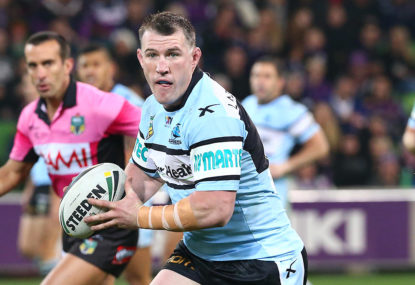Filled with expectation that this year’s inaugural World Club Series in England will survive the long haul, my mind is cast back some 40 years to an equally ambitious and successful concept that still brings a smile to the face.
A colourful splash enhanced rugby league’s monochrome image during the 1970s in a story that’s since faded. But, like the Chiko Roll snack of the time, it will never go away.
Three years before Kerry Packer brazenly launched World Series Cricket in 1977, rugby league had commenced a revolution of its own.
Inspired by improved sports coverage overseas following the introduction of colour television, Sydney-based entertainment promoter Colin McLennan dressed rugby league for the primetime with a cleverly disguised offload named the Amco Cup.
With telecasts mostly from Leichhardt Oval, the midweek knock-out tournament treated TV starved footy fans to a fresh Wednesday night alternative.
And thanks to the jeans manufacturer and Channel Ten, the comp pushed top tier participation beyond the traditional strongholds of Sydney and Brisbane.
In its first season, all 12 Sydney clubs plus the second-tier’s best were joined by Auckland and NSW country divisional sides.
The mix varied across the competition’s 16 years including combinations from regional Queensland, Brisbane, New Zealand and other Australian states, including the Northern Territory with Port Moresby taking part in the final four seasons.
Despite its doubters, the four-quarter format became a 1974 debut smash hit, with bushie outfit Western Division remarkably topping the charts in stunning Sydney’s elite.
Lounge lizards also scored, with broadcasts incorporating change room access and a red-faced Ray ‘Rabbits’ Warren, who reverberated in the path of Ansett’s thunderous low flying late arrivals.
Subsequent seasons provided more leather enclosed gems. Those worthy of inflation fill a vault emblazoned with brown and white hooped Steeden’s, diagonal striped in-goals, penalty count-back victories and silverware frothing with success.
The Balmain Tigers tasted more success than any other – upending the Cup after three of six contested finals – including their last, over Penrith in 1987 where five players jostled for seats in an oversubscribed Parramatta Stadium sin-bin.
Furthermore, the black and golds almost struck against the feed following victory over North Sydney in the 1976 final, with Allan McMahon incorrectly awarded the ‘Superstar of the Series’.
An embarrassing re-tally was enough for Bears and Great Britain international John Gray to belatedly accept the honour.
But that bungle seemed inconsequential to Eastern Suburbs fans 12 months later when rock-star fullback Russell Fairfax duffed a simple conversion following a superb kick-chase try that ultimately handed the Western Suburbs Magpies their last first-grade title with a famous 6-5 victory.
Although heartbreak for the Roosters was eased, safe in the knowledge their 1975 Cup-Premiership double was a first, subsequently matched by Parramatta’s pair in 1986.
Amco’s inspirational association came to an end in 1979, when for the last time, the player of the match squeezed into the seller’s finest denim.
A sensation not bestowed on the founding sponsor’s last trophy, which still stands alone in Cronulla’s spacious cabinet amid the echoes of Kurt Sorenson’s crunching defence.
On a night when Souths prop Peter Tunks shocked the scorers and centre Mitch Brennan raised the Cup before 23,079 fans – to this day a Leichhardt Oval ground record.
The Rabbitohs’ only midweek trophy was to be Tooth’s last, with naming rights transferred to iconic beer label KB for the 1982-83 seasons, both won by Manly.
The first coincided with the Tommy Raudonikis-led Newtown Jets’ last grand final in the big time, while the second – a win over Cronulla – confirmed a Sea Eagle resilience matched only by the sponsor’s ankle-busting dent-proof gold cans.
Legends Peter Sterling, Steve Rogers and Ray Price embraced the Cup concept, replicating their Rothmans Medal-winning form to earn ‘Superstar’ status under the midweek moonlight.
But it was Wally Lewis who shone brightest, skippering both victorious Brisbane-based outfits.
The crafty Queenslander far more efficient at blocking the shining lights of New South Wales than the black eye-polish donned by the games most gullible.
The King dominated the 1984 series, best remembered for exploiting the no-marker rule in scoring a decisive grand final try in Combined Brisbane’s 12-11 triumph over Easts.
Then five years later, backed up to collect the Brisbane Broncos’ maiden title after rolling a young Illawarra Steelers, whose aspirations rested in the unusually small shorts of two Wigan superstars, Andy Gregory and Steve Hampson.
By its final season in 1989, the founding mantra of the Cup still rang true. With the game’s widening appeal extended to Western Australia, the WACA hosted top-level league for the first time in a contest that saw Parramatta overrun Balmain before a packed house.
Eventually, the renamed Panasonic Cup had run its race. A victim of its own success, having stimulated two periods of premiership expansion through the inclusions of Canberra, Illawarra, Newcastle, Gold Coast and Brisbane.
Now more than 25 years later, as World Club Series organisers approach the pioneering kicking-tee. A favourable breeze of Amco inspired foresight may just be the entrepreneurial oomph that gets the new six-team format over the global expansion crossbar.





























































































